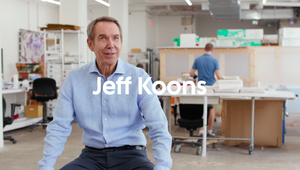
The Sweet Harmony of Capturing the Halcyon Days of Rave

At the end of the 1980s and beginning of the 1990s, during a time of extreme social division, Britain's youth basked in the peace, love and unity of the freshly launched acid house scene. Rave culture transcended all forms of division. It didn't matter what class or race you were, nor did anyone care where in the country you were from. Being together, in the moment, amidst a sea of limbs and lasers, was what was important.
Over the summer, an exhibition at the Saatchi Gallery in London remembered these halcyon days. Entitled 'Sweet Harmony' - named after the Liquid anthem - the launch film for the exhibition was directed by Oliver Warren, a director at Image Partnership.
LBB's Addison Capper chatted with Oliver about his approach to the film and the relevance of rave culture in the divided times of 2019.
LBB> What was the initial brief from Saatchi Gallery and Kobi Prempeh and why was this something you were keen to get involved in?
Oliver> When I first met with Saatchi, they were really open with the brief and excited to hear my vision of presenting the exhibition film as a piece of art in its own right - I think they fell in love with my idea of creating a living memory of those who were there at the core of this cultural movement. It’s the kind of brief I love, especially given access to each of the artists too - making films with passionate participants is always the dream.
LBB> How did you approach the film? What were your main aims and ambitions from a starting aspect?
Oliver> I started by studying the art on display, it was such a beautiful collision of visceral stolen moments in the still photographs and chaotic montages of club fliers and scattered memories. It evoked nights and parties from my own youth, and I became obsessed with both the intimacy of this art and the incoherence of memory.
LBB> It seems like the majority of the film is stock / old footage - what kind of challenges does this present for you as a director? And how did you give it its own feel and personality?
Oliver> Actually, none of the footage is stock / old footage, however, this was the exact look and feel I wanted to replicate. All of the footage was captured at the exhibition, by using handheld, dreamy movements, and shifting focus, to capture each element from the exhibition - breathing a new, urgent life into the still imagery from 20 years ago, and capturing the video exhibits in obscure angles and altered interpretations of the original footage. It was this erratic retelling of rave culture that I wanted to capture, an invite into the chaotic past.
LBB> What was the process like of pouring through all of the exhibition content?
Oliver> With it all to hand at the exhibition, one of my favourite parts of the process was discussing individual images with the artists; some were iconic images from their cherished past, and others recent discoveries from undeveloped films from forgotten nights. It was a delight to witness the artists’ experience up close - in particular Vinca Petersen, who assembled her timeline across a decade of rave culture, piecing together her own past for the first time.
LBB> What does the rave movement mean to you personally? What stage of your life were you in when it came to prominence and what did it mean to you then?
Oliver> I was about five years too late for the real heyday of rave culture, by the time I came of clubbing age everything had moved indoors to legitimate venues, so alas, the halcyon days each of the artist remembered are beyond my reach. Still, the culture of togetherness and freedom that they had created lived on and still resonated in Manchester in the '00s in the hard house scene that welcomed me in.
LBB> How relevant is the rave movement to life today? What similarities do you see between life back then and 2019?
Oliver> It’s funny, before becoming involved in this film my answer likely would have been 'not much' but then, meeting these artists and submerging myself in their art, I realise how rave culture was more than just an escape, it was a political statement of freedom beyond the confines society allowed, it was a protest against the restrictive politics of the day, and in that regard, 2019 is as in need of a rave scene as '90s Britain was.
LBB> Do you see any similar movements bubbling under now? What is the 'rave' of 2019? How powerful and significant do you think movements like rave are towards social change and politics?
Oliver> Rave culture was instrumental in awaking the youth of the time and giving them a focus, a movement of their own, and in that way, the twin movements of Extinction Rebellion and the school climate strikes, as inspired by Greta Thunberg are undoubtedly the movements that resonate with a youthful urgency today. Like rave, these aren’t safe, they aren’t sanctioned, and people are risking arrest, but, like rave, the ideals they inspire, are so god-damn important to the future of our species.
LBB> Any parting thoughts?
Oliver> Being inspired to make the connection between today’s environmental movement and the importance of rave culture has left me far more appreciative of what I might have otherwise categorised as my own misspent youth.










